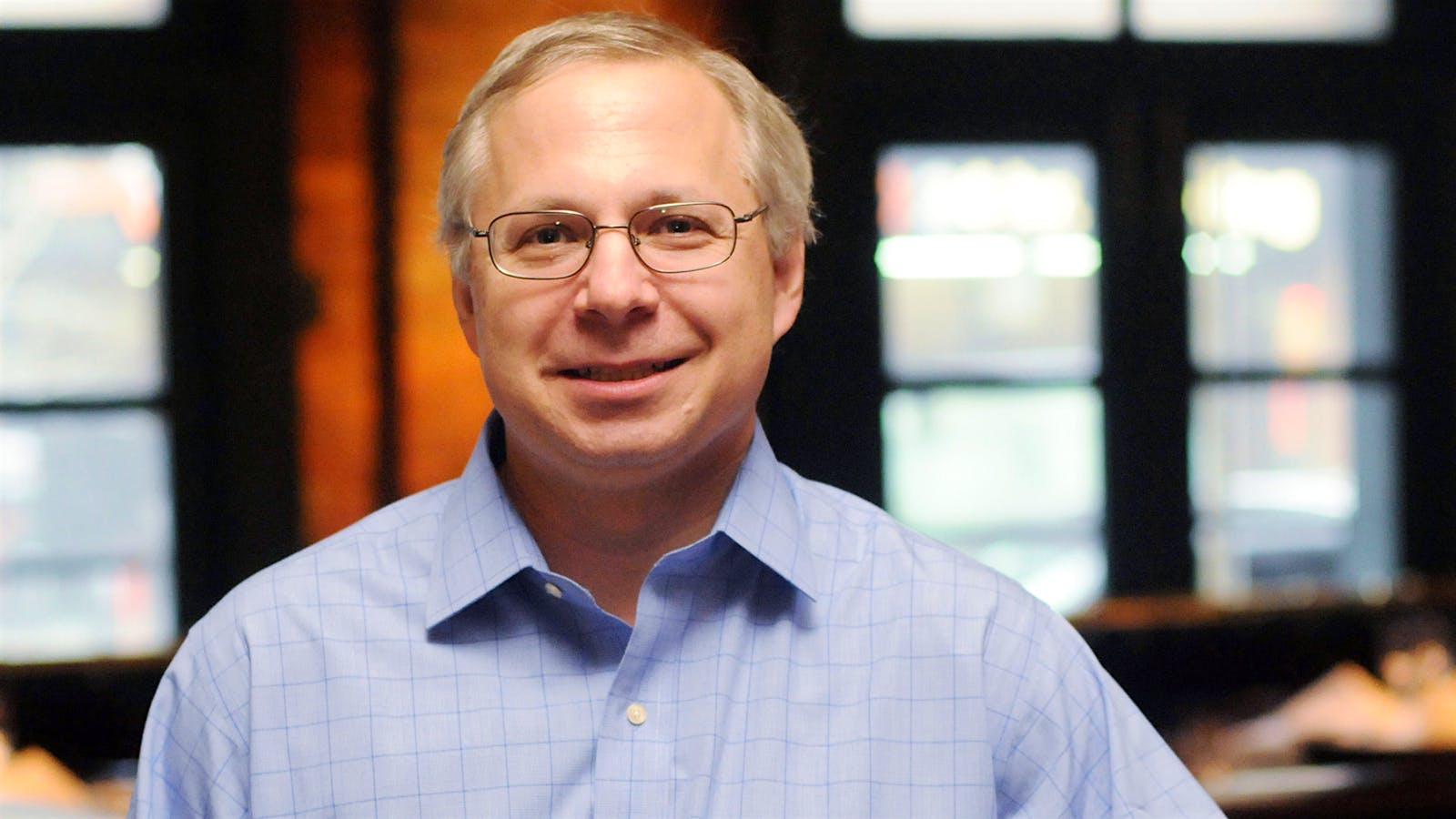Twenty-six years ago, Tribeca Grill opened under the ownership of actor Robert De Niro and restaurateur Drew Nieporent—with investments from Bill Murray, Mikhail Baryshnikov, Lou Diamond Phillips and Christopher Walken—in the Lower Manhattan neighborhood of the same name. Within six months, David Gordon, now 55, was hired as a manager.
In the quarter-century since, Gordon's role evolved into "wine steward," then "wine director" as he built Tribeca Grill's program to 2,200 selections. The restaurant earned a Wine Spectator Grand Award in 2002 with "the biggest list in the world of Châteauneuf-du-Pape, easily," and some of the lowest markups in town. In his career, the self-described "schmo from Brooklyn" has created lists for every sort of cuisine, from New French at Myriad Restaurant Group's Corton (now closed) to Japanese fusion at Nobu to airplane, as a consultant to Continental. Gordon, who has worked behind the scenes at Wine Spectator's Wine Experience on the sommelier team, has also mentored a flock of other sommeliers who've gone on to open highly accoladed restaurants of their own.
Associate editor Ben O'Donnell ventured downtown to ask Gordon about his early "wow" moments in the 1980s wine scene, the evolution of fine wine in America, stories from years at an iconic restaurant, and his secrets to success in a city where hundreds of ambitious restaurants have flown and foundered since Tribeca Grill opened.
Wine Spectator: Were you raised with a food-and-wine background, and if not, how did you come into it?
David Gordon: No, my dad was a travel agent [and] my mom was a high-school secretary. We never went out to eat. We went to a Chinese restaurant once every six months, New China Inn. Until I went to Cornell, I practically hadn't eaten anything other than pizza and baloney sandwiches or bagels. Later, my father would always say to me, "What do you do, anyway? I know you go to work, but don't the waiters come in, and the customers come in, and the chef cooks the food—like what do you do?" "I manage the place." "What do you mean you manage them, don't they just show up and it works?"
[After graduation], I worked at the Water Club as the banquet captain, started reading about wine and got into it on my own as a hobby. It just got to me, looking at the bottle and thinking, "Where does this come from, what is it like?"
WS: What was the New York food-and-wine scene like when you started? Do you have any specific fond memories?
DG: A friend of mine and I, we went to Jams, by Jonathan Waxman; it was the hottest thing in the '80s—California cuisine. They had a sommelier, and we were talking to him, and he said, "I think you're ready for Condrieu." I remember that was like, "Wow, this is really good, and it's flavorful and exotic."
At the Wine Experience my first year [1991], tasting 148 bottles at one time and pulling the corked bottles out, I didn't know if I was good enough to do it. I was with Roger Dagorn, Daniel Johnnes, Larry Stone, Peter Granoff, Steve Olson—everyone was more experienced than me. But I had to taste wines too, and when I found my first corked bottle, I was like, "Is this corked? Hey, I can do this." I was so happy: "Hey, I found a corked bottle!"
WS: Who were some of your early mentors, and how do you pass the skill of wine service on to your own sommeliers?
DG: You have to realize something about the '80s, which is that there were no American sommeliers in New York. It took Kevin Zraly, who became chief wine director at Windows on the World. There was a generosity in this business that I felt when I started. Daniel Johnnes, who did the list at Tribeca Grill before I started, was very generous; he was the one who invited me to work with Kevin at the Wine Experience. I always worked the wine dinners at [now-closed destination spot] Montrachet with Daniel and Tim Kopec.
I always train staff starting at zero knowledge. I also invite all the sommeliers and staff to any trade tastings that are available. Here, we pre-taste the wines before we serve. And my assistant sommeliers, they come in for the experience of tasting great wines while they're serving them. If I was opening a new restaurant, I would always bring [protégés] Yoshi Takamura and Patrick Cappiello into the tasting process. When suppliers would come, I would always bring the sommeliers along. Not everyone does that.
WS: What advice would you give young sommeliers today?
DG: You can have the most powerful person in their field come in, and when you hand them the wine list, they look at you like a puppy. I'm the expert now; they don't know anything. So you have to make it easy for people, and then they'll learn. The whole problem with it before was it was a French guy walking over with a tastevin and being a snob. We used to laugh at that. Now you have a young sommelier walking around with tattoos and a T-shirt being a snob—that's not good either. I tell my sommeliers all the time, "Don't look down on people." It doesn't make them a bad person or ignorant because they want to drink Cabernet from California that you think has too much alcohol.
It's great to have more knowledge than someone, but convey that in a friendly way. That attitude is one of the reasons we're here 26 years.
WS: How has the Tribeca Grill list evolved over the years?
DG: We're an American grill, so I thought, let's focus on American wines to start. In the early '90s, you had the cult Cabernets starting to come into the consciousness. '92 was the first vintage for Colgin, Bryant, Screaming Eagle. Helen Turley's wines, Marcassin, we started buying those immediately—'94, '95.
I always loved Rhône wines. And I decided that if we were going to build our list, we should focus on an area. Châteauneuf-du-Pape had many, many wines you could put on a list for $75 and under. The style of that wine—which is big, robust, with a little bit of spice—really suited the cuisine here, which was meat-focused; we always had intense flavors. And even in the year 2001, the consumer didn't know that much about the Rhône.
We also featured red Zinfandel in the beginning, back when white Zinfandel was the biggest thing, because those were great values. Old vines, big, concentrated flavors worked for this food and the clientele, and still do. So the list evolved in that direction: California and the Rhône.
My current favorite menu pairing is our 36-ounce dry-aged rib-eye for two, served with a great aged Châteauneuf-du-Pape, such as the Domaine St.-Préfert Auguste Favier 2006.
The key is buying smart, wines that age. When I look back 25 years, I wasn't thinking at the time, "Is this wine I'm going to want to have in 10 years?" But it worked out, because of these categories.
WS: How have wine lovers' tastes evolved?
DG: I've seen everyone wanting the cult wines, California, to almost no one wanting them. We've seen the whole rise and fall of Merlot, the rise and fall of Shiraz. We still have Shiraz on our list that was the hottest thing when I bought it 12 years ago, 99 points—nobody could care less.
But the main thing is people are more knowledgeable and more interested than they used to be, and some people are more willing to experiment once they gain the trust of the server or sommelier.
WS: Being De Niro's restaurant, Tribeca Grill has always attracted its share of celebrities. Any stories from serving them?
DG: I'm a big basketball fan, so I'll tell a Michael Jordan story. Michael Jordan, when he unretired back in the mid-'90s, it was a huge story. And [one of the first] games back, he scored 55 points against the Knicks. The night before that game, he came here with Bill Murray, Dan Aykroyd and Ahmad Rashad. Jordan actually called me over, and he was ordering the wine. He ordered the most expensive white wine on our list at the time, which was Corton Blanc from Chandon de Briailles, very small production. They drank it, they loved it, they went back into the kitchen and took pictures with everybody. On the way out, Marty Shapiro, the managing partner, goes, "You talked to Jordan. I have the same shoe size as him, 12 1/2. I can't get Air Jordans in my size. Will you ask him about it?" So I said, "I'll try." Two weeks a later, a box comes, Air Jordans, 12 1/2, from Michael Jordan. Marty slept in those sneakers for like a week.
Actually there was a restaurant basketball league for a while. Bobby Flay used to play, Tom Colicchio played. We played Monday mornings. That was before Bobby and Tom were on TV, so now they might be afraid to get injured! Whenever I see those guys, that's all we talk about is basketball. Now I just go and shoot around. I can still hit the three-pointer, though.












